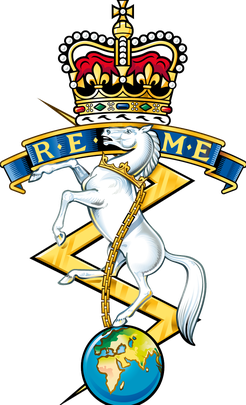
The Corps of Royal Electrical and Mechanical Engineers is the maintenance arm of the British Army that maintains the equipment that the Army uses. The corps is described as the "British Army's professional engineers".

In military organizations, the practice of carrying colours, standards, flags, or guidons, both to act as a rallying point for troops and to mark the location of the commander, is thought to have originated in Ancient Egypt some 5,000 years ago. The Roman Empire also made battle standards reading SPQR a part of their vast armies. It was formalized in the armies of Europe in the High Middle Ages, with standards being emblazoned with the commander's coat of arms.
The Indian Defence services have established numerous academies and staff colleges across India for the purpose of training professional soldiers in military sciences, warfare command and strategy, and associated technologies.

The Corps of Royal Canadian Electrical and Mechanical Engineers (RCEME) is a personnel branch of the Canadian Armed Forces (CF) that provides army engineering maintenance support. All members of the corps wear army uniform. From the 1980s to 2013 it was called the Electrical and Mechanical Engineering Branch.
Royal Electrical & Mechanical Engineer Corps is a corps of the Malaysian Army that is responsible for the maintenance of all vehicles, mechanical and electrical equipment of the Malaysian Army, with the exception of heavy equipments of the Rejimen Askar Jurutera DiRaja and signals equipment of the Rejimen Semboyan DiRaja.

The 23rd Indian Infantry Division was an infantry division of the Indian Army during World War II. It fought in the Burma Campaign. It was then reformed as a division of the independent Indian Army in 1959.
The Royal Corps of Australian Electrical and Mechanical Engineers is a corps of the Australian Army that has responsibility for the maintenance and recovery of all Army electrical and mechanical equipment. RAEME has members from both the Australian Regular Army and the Army Reserve.

The Sri Lanka Electrical and Mechanical Engineers (SLEME) (Sinhala: ශ්රී ලංකා විදුලි හා යාන්ත්රික ඉංජිනේරු රෙජිමේන්තුව Shri Lanka Viduli Ha Yanthrika Injineru Rejimentuwa) is a Combat Support corps of the Sri Lanka Army. It is made up of six regular regiments and one volunteer (reserve) regiment. Regiment Center located at Kew Road, Slave Island, Colombo. The present strength of the corps is 200 officers and 5763 other ranks.
Artificer sergeant major (ASM) is a senior warrant officer appointment in the technical branches of the British, New Zealand and Australian Armies.

The structure of the Pakistan Army is based on two distinct themes: operational and administrative. Operationally the Pakistan Army is divided into nine corps and three corps-level formations with areas of responsibility (AOR) ranging from the mountainous regions of the north to the desert and coastal regions of the south. Administratively it is divided in several regiments. The General Headquarters (GHQ) of the Army is located in Rawalpindi in Punjab province. It is planned to be moved to the capital city of Islamabad nearby.

The Regiment of Artillery is a combat/fighting arm of the Indian Army, which provides massive firepower during all ground operations of the Indian Army. It is a successor to the Royal Indian Artillery (RIA) of British Indian Army, which itself traces its origins to the formation of Bombay Artillery in 1827.

The Pakistan Army Corps of Electrical and Mechanical Engineering is a military administrative and the engineering staff branch of the Pakistan Army.
515 Army Base Workshop is a wing of Corps of Electronics and Mechanical Engineers (EME) of the Indian Army.
Major General Denis Arthur Kay Redman, CB, OBE was a senior British Army officer. He was Director of Electrical and Mechanical Engineering from 1960 to 1963 and therefore head of the Corps of Royal Electrical and Mechanical Engineers. He served as Colonel Commandant of REME from 1963 to 1968.

The Indian Army Service Corps (IASC) is a corps and an arm of the Indian Army which handles its logistic support function. It is the oldest and the largest administrative service in the Indian Army. While the history of supply and transport services is as old as the history of organized warfare itself it was in 1760 that the very rudimentary supply and transport organizations of the three presidencies of the East India Company were brought under the council of a single authority.
The Tyne Electrical Engineers (TEE) is a Volunteer unit of the British Army that has existed under various titles since 1860. It has been the parent unit for a large number of units fulfilling specialist coastal and air defence roles in the Royal Engineers (RE) and Royal Artillery (RA), many seeing service during both World Wars. TEE companies currently form part of the RE and of the Royal Electrical and Mechanical Engineers in the Army Reserve.

The Army Ordnance Corps is an active corps of the Indian Army and a major formation responsible for providing material and logistical support to the Indian Army during war and peace.
The Army Public School, Bhopal is a secondary school established in 1978 by the former Commander, Madhya Pradesh Sub Area, Brigadier K.P. Pande, MVC, FRGS in the form of Bal Vidya Vihar with the vision of providing low cost and quality education to the wards of defence personnel. It became Army Public School in Bairagarh in the barracks of 3 EME Centre.

The President's Colour Award is the highest honour that can be bestowed upon any military unit of India. It is also known as Nishaan, which is an emblem that is worn by all unit officers on the left-hand sleeve of their uniform.














